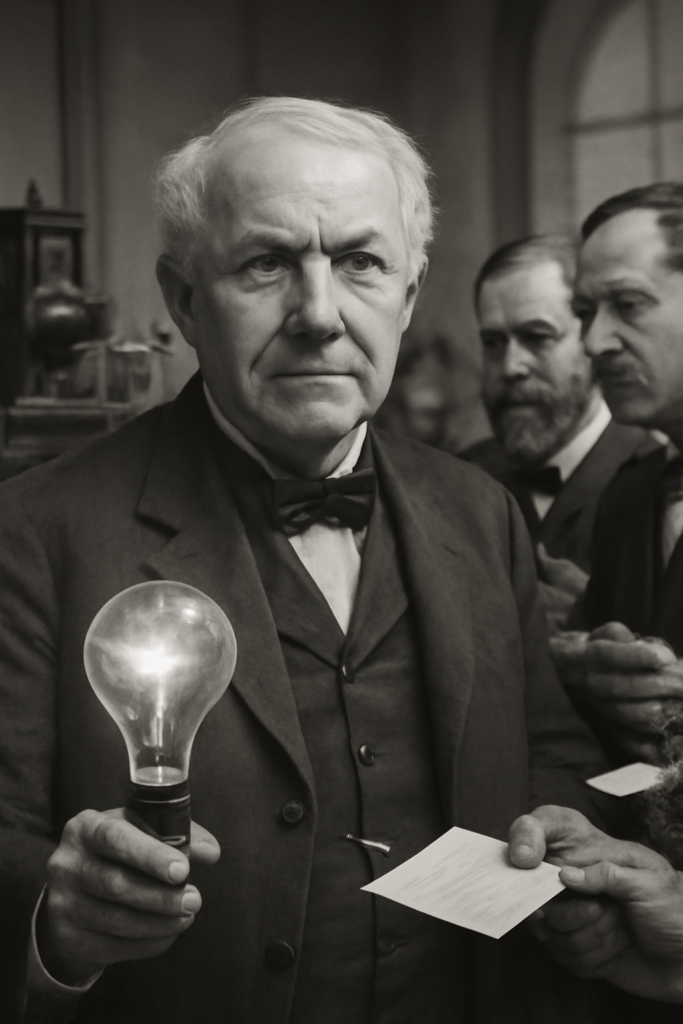
The story of a great inventor who achieved success through study, perseverance and the ability to communicate his ideas. The ideal recipe for those who want to help lead the world towards a more sustainable future… and maybe even earn a little money.
Thomas Alva Edison was born in Milan in 1847. And before Inter fans get nervous, it must be said that this is not the glorious capital of football, but a small town in Ohio, USA, which at the time had a population of less than a thousand and zero teams in the premier league. Thomas is certainly not the type to conform. From an early age, he is the child every teacher hopes not to have in the classroom: curious, restless, always with his hand raised to ask unlikely questions such as “Why is the sky blue?” or “How does telegraphy work?”. His curiosity, which would be a nightmare for any teacher, becomes the fuel for what will be one of the most brilliant careers in history. Thanks to the encouragement of his mother, who firmly believes that behind her son’s head always in the clouds lies a genius, Edison leaves school. He decides to study on his own, turning the family home into a laboratory where, instead of toys, there are science books, electric wires and a lingering smell of chemical experiments in progress.
The first steps into the world of innovation
In 1869, at the age of 22, Edison landed in New York with a few dollars in his pocket, a great desire to make it big and as much certainty about the future as a tourist without a map can have in an unknown metropolis.
His big break came with the invention of an improved telegraph, which enabled him to earn enough to open his first laboratory in Newark, New Jersey. From here on, Edison never stopped: among his first inventions was the phonograph, a machine capable of recording and reproducing sounds. At the time it sounds like magic, and indeed it is, as you can finally hear your mother-in-law’s voice again whenever you want. But it was in 1879 that Edison really changed the course of history with the invention that would make him immortal: the incandescent light bulb.
A light in the darkness
In those years, domestic lighting was a complicated and dangerous affair, dominated by gas lamps that were a bit like those pesky roommates: they shed light, yes, but at the risk of exploding at any moment. Edison, with his futuristic vision, intuits that electricity could be the solution to bring light into homes without blowing them up. However, making this intuition a usable reality is not exactly a walk in the park.
Many scientists have already attempted to create an electric light bulb, but their results have been a bit like New Year’s resolutions: bright for a moment, then quickly extinguished. The first light bulbs last only a few seconds before burning out. Edison, however, is not the type to be easily discouraged. He knows that the key to a long-lasting light bulb lies in the filament, that tiny wire that has to get hot enough to emit light, shine brightly enough and, above all, not destroy itself as soon as you start reading the newspaper.
The hunt for the perfect filament
In 1876, Edison moved his laboratories to a larger area in Menlo Park, New Jersey, where he began a series of experiments that could put even the most obsessive of perfectionists to shame. Edison tested everything in the hope of finding the perfect filament material: cotton thread, grass, hemp (talk about rope), horsehair, cat vibrissae, even beards and moustaches of friends.
After experimenting with thousands of materials, Edison and his team finally discovered that a charred bamboo filament, encased in a glass bulb almost devoid of oxygen, could last up to 40 hours. That’s a record. A curious detail: the idea of using bamboo did not come directly from Edison, but from a Japanese collaborator who, coming from a place where bamboo is used to make everything from fans to houses, must have thought that it might be the right material this time too.
Edison, with its experimental spirit, embraces the idea and… Bingo! The light bulb works and not just for a few minutes, but for hours. With further improvements, Edison’s light bulb now lasts an astonishing 1,200 hours: enough to fit in every home.
Menlo Park: the ideas factory
The Menlo Park laboratory becomes the first real ‘ideas factory’. Edison is an innovator not only in invention, but also in research method: he surrounds himself with a multidisciplinary team of scientists, engineers and skilled workers. Menlo Park becomes a creativity war machine, where people work day and night (thanks to the light bulb, of course) to turn ideas into reality. Edison is famous for his work pace that would put even the most workaholic manager to shame: he only sleeps a few hours a night, preferring short naps here and there. The light bulb is the result of this relentless dedication. Edison himself, with a hint of modesty, claims to have found ‘10,000 ways a light bulb doesn’t work’ before arriving at the right one. And so the light bulb was born: a symbol of ingenuity, perseverance and the ability to endure an endless series of failures without losing enthusiasm. Yes, alright, we use LEDs today; but let’s not forget that incandescent bulbs have been lighting us up for over a century.
Lighting up the world: from the laboratory to the marketplace
But inventing the light bulb is only half the job. Edison knows that an invention, to have a real impact, must be commercialised.
And this is where the entrepreneur Edison comes in. He doesn’t just want to sell light bulbs: he wants to build an electrical network that can power them, illuminating not only the homes of the rich, but also those of ordinary people. In 1882, Edison opened the world’s first commercial power station on Pearl Street in the heart of New York. This power station sends current to some 3,000 light bulbs, transforming an area of Manhattan into an island of light. It is a titanic feat, but Edison, besides being a brilliant inventor, is also a shrewd entrepreneur, able to convince investors and politicians of the importance of his vision. He is not only a man of science, but a true showman capable of turning each of his inventions into a media spectacle.
Edison’s legacy: not just light bulbs
Thomas Edison is not only the inventor of the light bulb, but a pioneer of modernity. With 1,093 patents to his name, he is the type that when he shows up at a technology fair, all the other inventors line up to ask for his autograph. His inventions range from audio and video recording systems to alkaline batteries and improvements in industrial processes.
But beyond his inventions, Edison leaves an even greater legacy: that of a man who was able to see beyond the immediate horizon, who was able to persevere in the face of failure and who always sought to improve the world through ingenuity and technology.
The importance of persevering and communicating
But that’s not all, he also proves to be a master in communicating his ideas. He does not just invent, but knows how to present his inventions to the public and investors, making sure they are understood and appreciated. This ability to communicate effectively is an integral part of his success and a key element that every innovator should consider.
Understanding the work of scientists who have gone before us, persevering in one’s efforts and knowing how to communicate one’s ideas are crucial to achieving results that improve the lives of humanity by guiding us towards a more sustainable future. And, if possible, they enable us to do so in style.
















